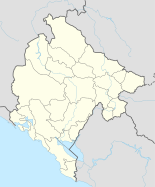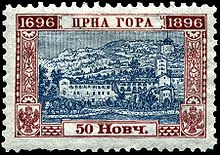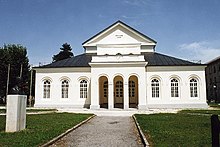Cetinje
|
Cetinje Цетиње |
||||
|
||||
| Basic data | ||||
|---|---|---|---|---|
| State : |
|
|||
| Coordinates : | 42 ° 24 ' N , 18 ° 55' E | |||
| Height : | 670 m. i. J. | |||
| Residents : | 13,918 (2011) | |||
| Telephone code : | (+382) 086 | |||
| License plate : | CT | |||
Cetinje ( Montenegrin - Cyrillic Цетиње ) is a city in Montenegro between Podgorica and Budva with about 13,900 inhabitants. It is located 670 meters above sea level in the Cetina valley at the foot of the Lovćen massif. Cetinje is the official residence of the Montenegrin President and was the capital of the country until 1918.
population
At the 2011 census, the city of Cetinje had 13,918 inhabitants. 12,705 (91.28%) were Montenegrins and 539 (3.87%) were Serbs . Members of other population groups also live in the city.
The entire municipality had 16,657 inhabitants, of which 15,082 (90.54%) described themselves as Montenegrins and 727 (4.36%) as Serbs .
history
It was founded in 1482. The oldest building in the city is the Vlaška crkva (German Wallachian Church). It was built around 1450 by shepherds living in the area, who were called Wallachians at that time . Ivan Crnojević , Prince of Zeta 1465-1490, is considered the founder of Cetinje. After the Ottomans took the Venetian Shkodra in 1479 , Ivan moved his seat of government from the endangered Žabljak on Lake Skadar to the mountains east of Lovćen . Here in 1482 he founded an Orthodox monastery consecrated to the Mother of God, which became the nucleus of Cetinje. In 1495 a printing shop was set up there.
From the end of the 15th century until 1918, Cetinje was the capital of Montenegro. First the princes of the Crnojević family resided here and from 1516 the Vladikas , the prince-bishops , who were the spiritual and secular heads of the Montenegrins until the middle of the 19th century. In 1692 the Turks conquered Cetinje and destroyed the monastery that was the seat of the bishop. 1696–1701, Vladika Danilo Petrović built a new monastery in almost the same place.
Under the penultimate Vladika Petar II. Petrović-Njegoš (1830-1851) the modernization of Cetinja began. Roads were paved and the first western-style houses were built. In 1838 the Vladika had a new princely residence built. This villa was popularly called Biljarda because Petar II had a billiard table set up there, a piece of furniture that was very unusual for Montenegro at the time.
Prince Nikola (1860-1918) expanded the small town into the modern capital of Montenegro, whose independence was internationally recognized in 1878. During this time, water pipes were laid, street lighting was installed and several schools, a hospital, a museum and a building for the state archive were built. The major European powers set up embassies that helped shape the new cityscape.
During the First World War , Cetinje was under Austrian occupation from 1916 to 1918 (see Austro-Hungarian occupation of Montenegro 1916–1918 ). After the war, when Montenegro became part of the new Yugoslav state , Cetinje lost its capital city function, but gained it again in the Independent State of Montenegro, which existed from 1941 to 1944 . When Montenegro was constituted as a part of the republic of Yugoslavia in 1946, however, Titograd (now Podgorica) was named the capital.
In 1967, Cetinje hosted the International Mathematical Olympiad .
Since independence in 2006, Cetinje has been the official seat of the President, but not of the government. Today Cetinje is a nationally important historical and cultural site. The city is home to the Faculties of Arts, Music and Drama of the University of Montenegro .
Attractions
Today some relatively well-preserved former royal and government buildings as well as a monastery can be visited. Two of the earlier palaces have been converted into museums. The numerous former embassy buildings of foreign countries, such as those of Russia or Austria-Hungary , are also architecturally interesting .
sons and daughters of the town
- Frédéric Rossif (1922–1990), director, screenwriter, photographer and documentary filmmaker
- Miodrag Djuric (Dado) (1933-2010), painter
- Žarko Marković (* 1986), Montenegrin-Qatari handball player
- Vasko Ševaljević (* 1988), handball player
- Marija Vuković (* 1992), high jumper
- Vladan Lipovina (* 1993), handball player
- Vuko Borozan (* 1994), handball player
Sister cities / friendly municipalities
literature
- Sergio Anselmi (ed.): Sette citta jugo-slave tra Medioevo e Ottocento: Skoplje, Sarajevo, Belgrado, Zagabria, Cettigne, Lubiana, Zara. Senigallia 1991.
- Dušan Martinović, Uroš Martinović: Cetinje. Spomenici arhitekture. Cetinje 1980.
- Pavle Mijović: Cetinje kao feniks. Cetinje 1997, ISBN 86-7079-061-0 (Culture and City History).
- Boro Radonjič: Cetinje and the Montenegrin coastal region. Beograd 1955.
Web links
- Website of the municipality of Cetinje (Serbian, English)
- Pictures from Cetinje
- Information about Cetinje as part of the “New Economic Geography” map of the European Stability Initiative (ESI)






